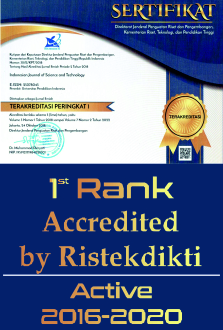Sensitivity of Junction Width to Tidal Nonlinearity on Small and Shallow Tidal Junction
Abstract
Keywords
Full Text:
PDFReferences
Amin, M. H., Sajak, A. A. B., Jaafar, J., Husin, H. S., and Mohamad, S. (2021). Real time water quality monitoring system for smart city in Malaysia. ASEAN Journal of Science and Engineering, 2(1), 47–64.
Arif, N., Danoedoro, P., and Mulabbi, A. (2020). Erosion prediction model using fractional vegetation. Indonesian Journal of Science and Technology, 5(1), 125–132.
Bilskie, M. V., Bacopoulos, P., and Hagen, S. C. (2019). Astronomic tides and nonlinear tidal dispersion for a tropical coastal estuary with engineered features (causeways): Indian River lagoon system. Estuarine, Coastal and Shelf Science, 216, 54–70.
Buschman, F. A., Hoitink, A. J. F., Van Der Vegt, M., and Hoekstra, P. (2010). Subtidal flow division at a shallow tidal junction. Water Resources Research, 46(12), 1–12.
Cai, H., Toffolon, M., Savenije, H. H. G., Yang, Q., and Garel, E. (2018). Frictional interactions between tidal constituents in tide-dominated estuaries. Ocean Science, 14(4), 769–782.
Danial, M. M., Kawanisi, K., and Al Sawaf, M. B. (2019). Characteristics of tidal discharge and phase difference at a tidal channel junction investigated using the fluvial acoustic tomography system. Water (Switzerland), 11(4), 1-21.
Guo, L., Wegen, M. van der, Jay, D. A., Matte, P., Wang, Z. B., Roelvink, D., and He, Q. (2015). River-tide dynamics: Exploration of nonstationary and nonlinear tidal behavior in the Yangtze River estuary. Journal of Geophysical Research C: Oceans, 120, 3499–3521.
Hoitink, A. J. F., Hoekstra, P., and Van Maren, D. S. (2003). Flow asymmetry associated with astronomical tides: Implications for the residual transport of sediment. Journal of Geophysical Research C: Oceans, 108(10), 1-8.
Horrevoets, A. C., Savenije, H. H. G., Schuurman, J. N., and Graas, S. (2004). The influence of river discharge on tidal damping in alluvial estuaries. Journal of Hydrology, 294(4), 213–228.
Iwantoro, A. P., van der Vegt, M., and Kleinhans, M. G. (2022). Stability and asymmetry of tide‐influenced river bifurcations. Journal of Geophysical Research: Earth Surface, 127(6), 1-24.
Iwantoro, Arya P., Van Der Vegt, M., and Kleinhans, M. G. (2020). Morphological evolution of bifurcations in tide-influenced deltas. Earth Surface Dynamics, 8(2), 413–429.
Khadami, F., Kawanisi, K., Al Sawaf, M. B., Gusti, G. N. N., and Xiao, C. (2022). Spatiotemporal response of currents and mixing to the interaction of tides and river runoff in a mesotidal estuary. Ocean Science Journal, 57(0123456789), 37–51.
Khadami, F., Kawanisi, K., and Tarya, A. (2020). Tidal asymmetry in two-inlet lagoon: a case study on Segara Anakan Lagoon, Central Java, Indonesia. Journal of Japan Society of Civil Engineers, Ser. B1 (Hydraulic Engineering), 76(2), 1411-1416.
Kukulka, T., and Jay, D. A. (2003). Impacts of Columbia River discharge on salmonid habitat: 1. a nonstationary fluvial tide model. Journal of Geophysical Research: Oceans, 108(9), 1-20.
Lu, S., Tong, C., Lee, D. Y., Zheng, J., Shen, J., Zhang, W., and Yan, Y. (2015). Propagation of tidal waves up in Y angtze E stuary during the dry season. Journal of Geophysical Research: Oceans, 120(9), 6445-6473.
MacMahan, J., van de Kreeke, J., Reniers, A., Elgar, S., Raubenheimer, B., Thornton, E., Brown, J. (2014). Fortnightly tides and subtidal motions in a choked inlet. Estuarine, Coastal and Shelf Science, 150(PB), 325–331.
Matte, P., Secretan, Y., and Morin, J. (2019). Drivers of residual and tidal flow variability in the St. Lawrence fluvial estuary: Influence on tidal wave propagation. Continental Shelf Research, 174(2018), 158–173.
Pareta, K., and Pareta, U. (2017). Geomorphological analysis and hydrological potential zone of Baira River Watershed, Churah in Chamba district of Himachal Pradesh, India. Indonesian Journal of Science and Technology, 2(1), 26–49.
Pawlowicz, R., Pawlowicz, R., Beardsley, R. C., Beardsley, R., Lentz, S., and Lentz, S. (2002). Classical tidal harmonic analysis including error estimates in MATLAB using T_TIDE. Computers and Geosciences, 28(8), 929–937.
Sassi, M. G., and Hoitink, A. J. F. (2013). River flow controls on tides and tide-mean water level profiles in a tidal freshwater river. Journal of Geophysical Research: Oceans, 118(9), 4139–4151.
Sassi, M. G., Hoitink, A. J. F., Vermeulen, B., and Hidayat, H. (2013). Sediment discharge division at two tidally influenced river bifurcations. Water Resources Research, 49(4), 2119–2134.
Savenije, H. H. G., Toffolon, M., Haas, J., and Veling, E. J. M. (2008). Analytical description of tidal dynamics in convergent estuaries. Journal of Geophysical Research: Oceans, 113(10), 1–18.
Wagner, W., and Mohrig, D. (2019). Flow and sediment flux asymmetry in a branching channel delta. Water Resources Research, 55(11), 9563–9577.
Wu, Y., Hannah, C., Matte, P., O’Flaherty-Sproul, M., Mo, R., Wang, X., and MacAulay, P. (2022). Tidal propagation in the Lower Fraser River, British Columbia, Canada. Estuarine, Coastal and Shelf Science, 264(2021), 107695.
Xiao, C., Kawanisi, K., and Al Sawaf, M. B. (2020). Suspended particulate matter concentration in response to tidal hydrodynamics in a long mesotidal floodway. Estuarine, Coastal and Shelf Science, 233(2019), 106525.
Xiao, C., Kawanisi, K., Torigoe, R., and Al Sawaf, M. B. (2021). Mapping tidal current and salinity at a shallow tidal channel junction using the fluvial acoustic tomography system. Estuarine, Coastal and Shelf Science, 258, 107440.
DOI: https://doi.org/10.17509/ijost.v7i2.49856
Refbacks
- There are currently no refbacks.
Copyright (c) 2022 Universitas Pendidikan Indonesia

This work is licensed under a Creative Commons Attribution-ShareAlike 4.0 International License.
Indonesian Journal of Science and Technology is published by UPI.
View My Stats





















